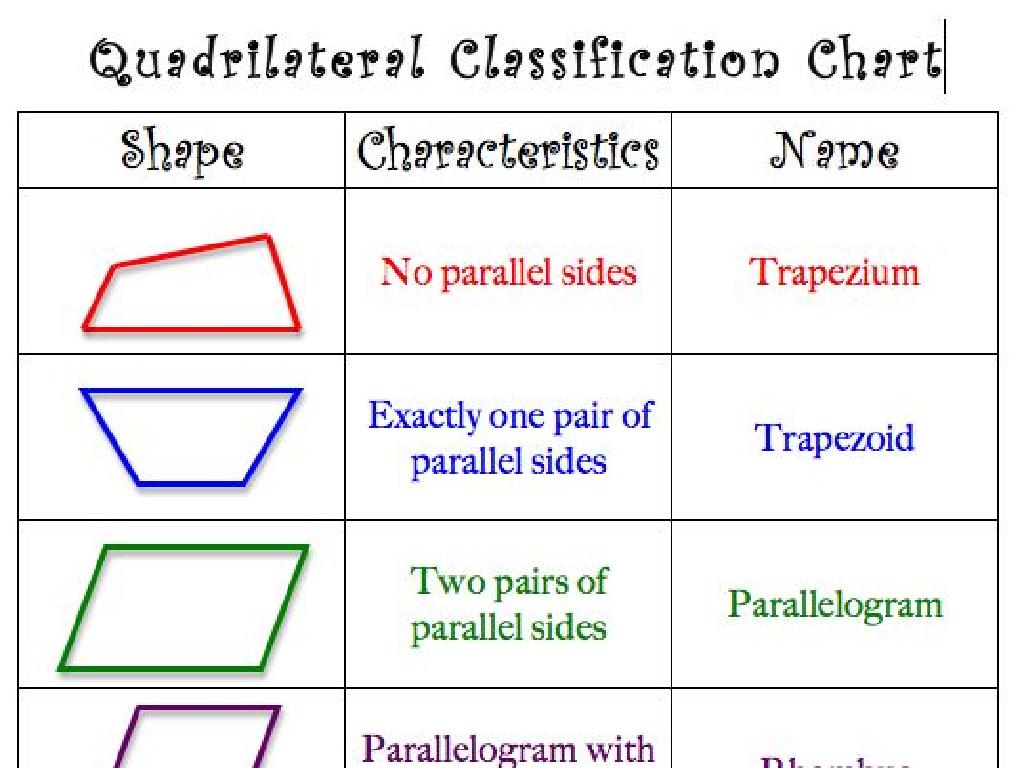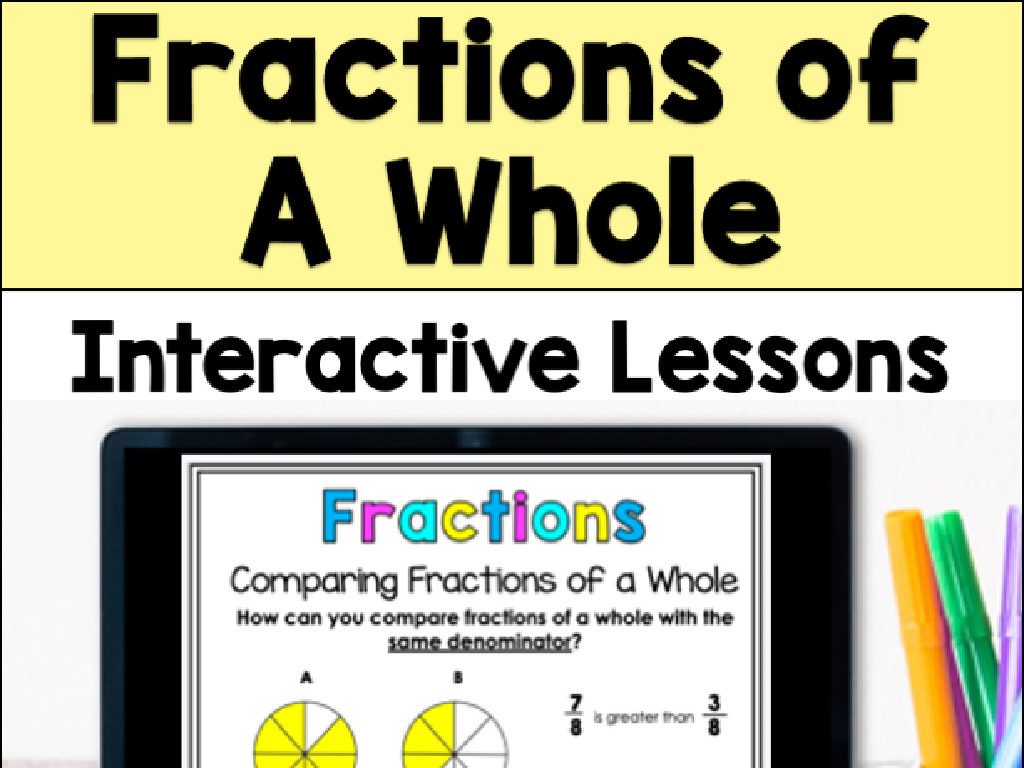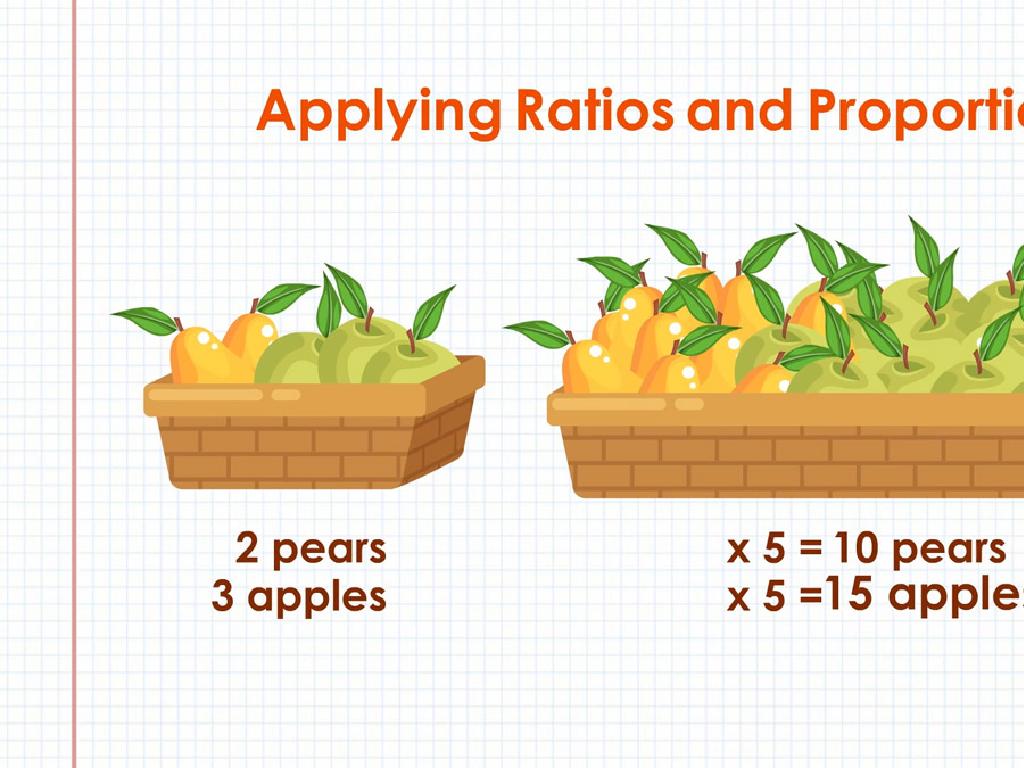How Does Particle Motion Affect Gas Pressure?
Subject: Science
Grade: Sixth grade
Topic: Particle Motion And Energy
Please LOG IN to download the presentation. Access is available to registered users only.
View More Content
Particle Motion and Energy: Gas Pressure
– Particles in gases are always moving
– Imagine tiny balls constantly bouncing in a room
– Faster motion means higher pressure
– When heated, particles move faster, like popcorn in a popper
– Temperature affects particle speed
– Warm gas particles zip around quicker than cold ones
– More particles can increase pressure
– A balloon inflates as more air particles are added inside
|
This slide introduces the concept of particle motion in gases and its relation to gas pressure, a fundamental topic in understanding the behavior of gases. Emphasize that particles in gases are in constant, random motion and that this motion is related to the energy the particles possess. Explain that increased temperature leads to increased particle speed, which in turn can increase the pressure of the gas. Use relatable examples such as a heated popcorn kernel or inflating a balloon to illustrate these concepts. Encourage students to visualize particles as tiny, invisible balls in constant motion, colliding with each other and the walls of their container, causing pressure. This visualization will help them grasp how changes in motion and the number of particles can affect gas pressure.
Exploring Matter: Focus on Gases
– Matter: Everything’s building block
– Matter is what all things are made of.
– States of matter: Solid, Liquid, Gas
– Matter can be hard like ice, flow like water, or spread out like steam.
– Today’s focus: Gaseous state
– We’ll learn about the properties of gases.
– How gas particles move and create pressure
– Gas particles move freely and can push on things, which we feel as pressure.
|
This slide introduces the concept of matter and its different states, with a particular focus on gases. Begin by explaining that everything in the universe is made up of matter. Highlight the three states of matter: solid, liquid, and gas, and explain that they differ in the arrangement and movement of their particles. Emphasize that today’s lesson will delve into the gaseous state, exploring how the motion of gas particles relates to the pressure they exert. Encourage students to think about experiences they’ve had with gases, like balloons or the air around us, to make the topic relatable. The goal is to build a foundation for understanding how particle motion affects gas pressure.
Particle Motion in Gases and Gas Pressure
– Gas particles are in constant motion
– Particles move straight until collision
– Collisions with walls create pressure
– When particles hit the container’s walls, it causes the pressure we can measure
– Exploring particle-wall collisions
– We’ll investigate how the speed and frequency of collisions affect pressure
|
This slide introduces the concept of particle motion in gases and how it relates to gas pressure. Emphasize that gas particles are always moving in all directions and that they only change direction when they collide with something, such as other particles or the walls of their container. Explain that gas pressure is the result of these countless tiny collisions against the container walls. The more frequent and forceful these collisions are, the higher the pressure. To illustrate this, you can discuss how a balloon feels firmer as it is inflated due to increased collisions from the trapped gas particles. Encourage students to think about how temperature might affect particle motion and, consequently, gas pressure.
Pressure: The Result of Particle Collisions
– Particles colliding with container walls
– Gas particles move and hit the container’s sides, causing pressure.
– More collisions increase pressure
– If particles hit the walls more often, the pressure goes up.
– Factors affecting collision rate
– Temperature and volume changes can make particles collide more or less.
– Exploring temperature and volume effects
|
This slide introduces the concept of pressure in gases as a result of particle collisions. Explain that gas pressure is the force exerted by gas particles as they strike the surfaces of their container. More frequent collisions result in higher pressure. Discuss with students how changing the temperature can increase the energy of the particles, leading to more collisions and higher pressure. Similarly, reducing the volume of the container forces particles closer together, increasing the likelihood of collisions. Use examples like inflating a balloon to illustrate how the container’s size affects the pressure. Encourage students to think about other factors that might influence the number of collisions, such as the amount of gas or the presence of other forces.
Factors Affecting Gas Pressure
– Temperature’s role in pressure
– Higher temperatures make particles move faster, increasing pressure.
– Volume’s impact on gas pressure
– Reducing volume causes particles to collide more often, raising pressure.
– Particle number affects collisions
– More particles in a space increase collision frequency, affecting pressure.
– Understanding pressure changes
|
This slide aims to explain the relationship between particle motion and gas pressure to sixth-grade students. Emphasize that temperature affects the speed at which particles move; the higher the temperature, the faster they move, which can increase pressure. Explain how the volume of the container holding the gas can also affect pressure; a smaller volume means particles have less space to move, so they collide more often, increasing pressure. Additionally, the number of particles in a given volume can affect how often collisions occur; more particles lead to more collisions and higher pressure. Use analogies like a crowded room where people are more likely to bump into each other to help students visualize the concepts.
Real-Life Example: How Heat Affects Balloons
– Balloons expand with heat
– Heated air particles move faster, causing more collisions and expansion
– Balloons shrink when cooled
– Cooler temperatures slow particles, reducing collisions and volume
– Experiment: Heat vs. Balloon size
– We’ll heat and cool a balloon to see changes
– Observing particle motion effects
|
This slide uses the familiar example of balloons to illustrate how particle motion affects gas pressure. When a balloon is heated, the air particles inside gain energy and move faster, colliding more often and with greater force, causing the balloon to expand. Conversely, cooling the balloon slows down the particles, leading to fewer collisions and a decrease in volume, making the balloon shrink. To make this concept tangible, we’ll conduct a class experiment where we heat a balloon and observe its expansion, then cool it to see it shrink. This hands-on activity will help students visualize the relationship between particle motion and gas pressure.
Class Activity: Temperature and Pressure
– Heat up a balloon and observe changes
– Cool down the balloon and observe again
– Record observations on temperature effects
– Note the size of the balloon as it heats and cools
– Discuss how temperature affects gas pressure
– Relate observations to particle motion and pressure
|
This activity is designed to help students visually and practically understand the relationship between temperature and gas pressure. Provide each student or group with a balloon. As they heat the balloon (safely, with adult supervision), they should observe the expansion. When cooling the balloon, they should notice it contracts. Students should record the size changes at different temperatures. This will help them understand that increased temperature causes particles to move faster and spread apart, increasing pressure, while decreased temperature slows particles down, decreasing pressure. Possible activities: 1) Measure balloon circumference at different temperatures, 2) Use a thermometer to record the temperature of the air inside the balloon, 3) Compare balloons with different amounts of air, 4) Graph temperature vs. balloon size, 5) Discuss real-life applications, like car tires on hot days.
Conclusion: Particle Motion and Gas Pressure
– Gas particles move randomly
– Collisions cause gas pressure
– Particles hit container walls, creating pressure
– Temperature affects pressure
– Higher temperature increases particle speed, raising pressure
– Volume and particles alter pressure
– Changing container size or particle amount changes pressure
|
As we wrap up, remember that gas particles are in constant, random motion. This motion is what leads to gas pressure, as particles collide with the walls of their container. The pressure can be affected by several factors: increasing the temperature makes particles move faster, which can increase pressure; changing the volume of the container gives particles more or less room to move, affecting pressure; and adding or removing particles changes the frequency of collisions with the walls. It’s important to understand these relationships as they form the basis of gas laws in chemistry and physics. Encourage students to think of real-life examples, such as a basketball being inflated or a balloon expanding in the sun.
Homework: Particle Motion & Gas Pressure
– Complete the worksheet provided
– Include a real-world application
– Example: How a balloon expands when heated
– Be ready for a class discussion
– Reflect on how motion affects pressure
– Think about how faster-moving particles might push harder against surfaces
|
This homework assignment is designed to reinforce the concepts learned in class about the relationship between particle motion and gas pressure. Students are expected to complete the worksheet, which will contain questions and problems related to how the speed and movement of particles within a gas can affect pressure. Additionally, they should think of a real-world application of this concept, such as the expansion of a balloon when it’s heated, to illustrate their understanding. During the next class, students will engage in a discussion to share their findings and thoughts, allowing them to learn from each other’s insights. Encourage students to think critically about how increased motion (kinetic energy) of particles can lead to increased pressure, and vice versa, and how this principle is observable in everyday life.





